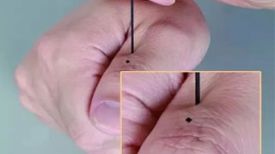Dizziness refers to a disease characterized by dizziness, dizziness, spinning of the sky and earth, and nausea and vomiting. Modern medicine categorizes dizziness into three types: basilar artery insufficiency, cervical origin, and ear origin. Traditional Chinese medicine divides dizziness into different syndrome types, such as liver yang hyperactivity, qi and blood deficiency, kidney qi deficiency, and phlegm turbidity obstruction.
Treatment points
The selection of acupoints is mainly based on the Du meridian and the Shaoyang meridians of the hands and feet. Usually, the following three acupoints are selected. Among them, the forehead acupoint (the author's experience acupoint) is more commonly used and has a better effect. Ezhong acupoint is suitable for Qi and blood deficiency type and kidney qi deficiency type. Yanglingquan acupoint is suitable for liver yang hyperactivity type. Fenglong acupoint is suitable for phlegm obstruction type.
Operation method:
Yanglingquan acupoint: Take a sitting or supine position, with the fibular head tilted down 1 inch into a depression, and disinfect the skin regularly. Use a 28 gauge 2-inch stainless steel filiform needle to directly puncture Yanglingquan acupoint. After obtaining qi, use the lifting and inserting twisting and reducing method for empirical evidence, the supplementing method for deficiency syndrome, and the flat supplementing and reducing method for deficiency and excess mixed syndrome. Each twisting interval is about 10 minutes, with a total of 3 twists. For mild cases, one course of treatment lasts for 7 days, while for severe cases, two courses of treatment are required.
Ezhong acupoint: It is an experiential acupoint located at the midpoint of the line connecting the middle of the upper hairline and the Yintang acupoint. The skin is routinely disinfected, and a 28 gauge, 2-inch stainless steel filiform needle is used to stab the Ezhong acupoint about 1.5 inches. After obtaining qi, the empirical acupoint is treated with lifting, inserting, twisting, and reducing methods. The deficiency syndrome is treated with tonifying, and the deficiency and excess syndrome is treated with leveling, supplementing, and reducing methods.
Fenglong point: 8 inches above the outer ankle tip, 1 inch outside the Tiaokou point, and 2 horizontal fingers outside the anterior tibial crest. Routine disinfection of the skin is performed using a 28 gauge 2-inch stainless steel filiform needle, which is inserted directly into the Fenglong acupoint for about 1.5 inches. After obtaining qi, the method of lifting, inserting, twisting, and reducing is used for empirical diagnosis, while the method of supplementing and reducing is used for deficiency syndrome, and the method of flat supplementing and flat reducing is used for deficiency and excess mixed syndrome. For mild cases, one course of treatment lasts for 7 days, while for severe cases, two courses of treatment are required.
Case 1 Dizziness (Liver and Kidney Deficiency)
Miao, female, 32 years old, worker, first diagnosed on December 28, 2008. Complaint of dizziness for 3 days. Three days ago, due to emotional distress, I experienced dizziness, bloating, and insomnia. The next day, my blood pressure was 140/80mmHg, and the local doctor diagnosed me with Meniere's disease. I received intravenous therapy but it did not work. When coming for diagnosis, dizziness worsens, accompanied by hair swelling, eye socket swelling and pain, dry mouth and thirst, tinnitus, no discomfort in the neck, sore waist and knees, fatigue and weakness, irritability, moderate diet, poor sleep, balanced bowel movements, light red tongue, thin and white coating, thin and stringy pulse, and weak feet.
This is due to liver and kidney deficiency, loss of nourishment in the liver, retrograde liver qi, and dizziness caused by wind movement. Choose the acupoint in the forehead for flat needling.
Treatment process: Routine disinfection of the skin, using a 28 gauge 3-inch stainless steel filiform needle to stab the forehead and middle acupoint. After obtaining qi, use the laxative method to twist and rotate for about 1 minute. The dizziness is slightly mild, and twist and rotate once every 15 minutes. After 3 injections, the dizziness disappears and the head turns clear. Like a normal person, once a day, with 3 consecutive injections to consolidate. Follow up for 3 months without recurrence.
The head is the meeting point of various yang, and the three yang meridians of hands and feet all converge on the head. The acupoint in the forehead belongs to the Du meridian, which governs yang and passes through the spine and belongs to the kidney. The dizziness in this case was caused by emotional distress, dizziness, eye socket swelling and pain, poor sleep, and was related to insufficient kidney yin, loss of liver nourishment, and reversal of liver qi. Puncturing the forehead middle point, dizziness returns to normal and recovers, indicating that the forehead middle point has the functions of regulating and tonifying kidney yin, nourishing liver wood, calming liver qi, clearing the brain and opening the orifices. Therefore, it can be inferred that needling the forehead middle point can nourish the kidney and treat the liver, and dizziness can be relieved.
Case 2 Dizziness (obstructed by phlegm)
Zhang, female, farmer, from Hebei, was diagnosed on December 9, 2008. Dizziness attack for 2 days. Consciously turning the sky and the earth, feeling nauseous and nauseous, not daring to move. If moving, dizziness will worsen. After multiple treatments, it is ineffective. Come and seek medical attention. Diagnosis: Blood pressure 120/80mmHg, dizziness and heaviness, pale red tongue, white and greasy coating, and fine pulse.
This is the obstruction of phlegm in the middle, with the upper Mongolia clearing the orifices. The treatment is to dispel dampness and phlegm, elevate clarity and reduce turbidity, and take Fenglong acupoint for acupuncture.
Treatment process: Take Fenglong acupoint, disinfect the skin regularly, use a 28 gauge 3-inch stainless steel filiform needle to directly puncture Fenglong acupoint. After obtaining qi, use the laxative method to twist and rotate for 1-2 minutes. The dizziness is immediately relieved, and the head turns clear. Twist and rotate every 15 minutes, leaving the needle for 60 minutes. Treatment once a day, continuous injection for 2 days, all symptoms resolved, consolidation treatment 5 times, follow-up for 1 year, no recurrence.
This case of dizziness is characterized by obstruction of phlegm in the middle, nausea and vomiting, which is related to the inversion of stomach qi. It was cured by directly needling the Fenglong acupoint with a laxative method. Fenglong acupoint is treated with laxative therapy, which has the functions of calming stomach qi, resolving phlegm and dampness, and promoting clarity and turbidity. Acupuncture at Fenglong acupoint clears the mind and stops dizziness. From this, it can be seen that the turbid qi decreases, the clear qi rises, and dizziness self heals.
Case 3: Insufficient blood supply to the vertebral basilar artery (phlegm dampness internal obstruction)
Hou, female, 73 years old, retired worker. Initial diagnosis on June 20, 2007. Dizzy for 6 hours. At 2:40 in the afternoon, I suddenly felt dizzy and had a headache. The sky was spinning and the ground was spinning, and people around me were supporting me to lie down on the bed. When I turned over, dizziness recurred, and I felt nauseous without vomiting or tinnitus. Cranial Doppler ultrasound examination: Insufficient blood supply to the vertebral basilar artery. Having a plump physique, the stomach is blocked and stuffy, with hiccups, nausea and vomiting, dry mouth, and bitter taste. Blood pressure is 160/80mmHg, tongue texture is light red, coating is thin and white, pulse is thin and stringy, and left Guan Xian is large.
This dizziness is characterized by excessive liver yang, phlegm turbidity and internal obstruction, which can obscure and clear the orifices. Treat with calming the liver and calming the wind, dispelling phlegm and opening the orifices. Take a single needle from Yanglingquan acupoint.
Treatment process: Take a 3-inch filiform needle on the 28th, disinfect the skin at the acupoint, and then directly prick Yanglingquan acupoint, about 1.5 inches, causing soreness, bloating, and numbness. After obtaining a sense of qi, use the laxative method to continue twisting for about 30 seconds. Dizziness and headache will stop immediately, and the remaining symptoms will disappear. Twist once every 5 minutes, a total of 5 twists. Follow up for 4 years, no recurrence.
Yanglingquan acupoint is the meeting point of the tendons and meridians, and is the Shaoyang gallbladder joint acupoint. Select Yanglingquan acupoint to calm the liver and gallbladder, so as to calm the liver qi and lower the stomach qi. From this, it can be seen that single point direct needling of Yanglingquan has a good therapeutic effect in treating dizziness and improving insufficient blood supply to the vertebral basilar artery.
Clinical experience
Dizziness is more common in clinical practice, with sudden onset and severe symptoms. Western medicine uses methods such as intravenous infusion to dilate blood vessels, promote blood circulation and remove stasis, and improve microcirculation to treat it. However, the treatment time is often long and persistent. Traditional Chinese medicine is treated according to phlegm, deficiency, wind syndrome, etc., and the effect is slow, but acupuncture and moxibustion has a fast effect and a high cure rate. Especially with acupuncture at the middle point of the forehead, dizziness can be immediately relieved after acupuncture. As long as the treatment is effective, most cases will be cured 1-3 times, followed up, and it is not easy to relapse for a long time.
The Ezhong acupoint is the author's experience acupoint, belonging to the Du meridian. The Du meridian runs through the spine and belongs to the kidney, while the brain is the sea of marrow. Due to kidney deficiency, the sea of marrow is insufficient, and the brain loses nourishment, resulting in dizziness. Clinically, it has been found that acupuncture at the forehead middle point has a good therapeutic effect on Qi and blood deficiency type, kidney qi deficiency type, dizziness attack type, and traumatic dizziness.
Special acupoints for treating dizziness and dizziness
Release time:2024-06-08 17:18:06
Reading:171
Word Count:10412
Subscribe to email


